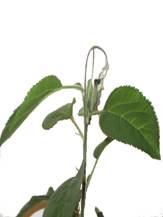 Molecular analysis of the outer membrane protein, TolC, in Erwinia amylovora
Molecular analysis of the outer membrane protein, TolC, in Erwinia amylovora
The enterobacterium Erwinia amylovora causes fire blight on several plant species with economic importance on apple and pear. Infected plants produce phytoalexins such as flavonoids, isoprenoids, and alkaloids as biochemical defense mechanisms against pathogens. A successful pathogen develops resistance mechanisms to combat the effect of these toxic compounds. AcrAB-TolC multidrug efflux transporters which mediate resistance toward structurally unrelated compounds might confer tolerance to these phytoalexins. To prove this hypothesis, single acrAB and tolC mutants and a double mutant (acrAB tolC) were constructed to study the influence of these mutants on the minimal inhibitory concentrations of different antimicrobial compounds and phytoalexins and virulence of E. amylovora. Likewise, TolC might also play role in protein secretion as a porin of the type I secretion system. Analysis of secreted proteins is currently being conducted to investigate the role of tolC in protein secretion of E. amylovora.
